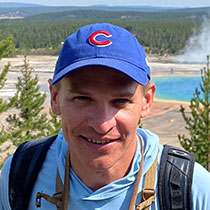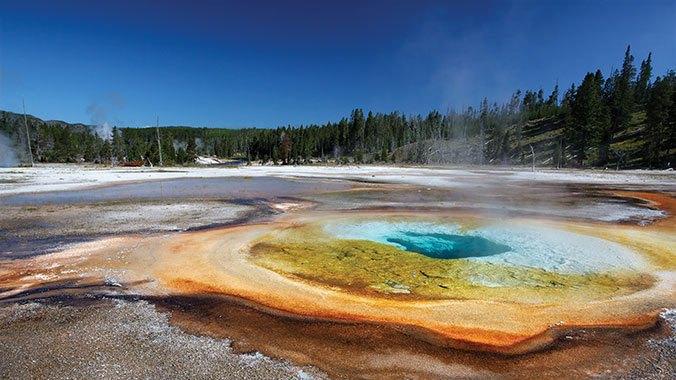After the Fires: The Ecology of Change in Yellowstone National Park
by Linda Wallace, Editor
The ravaging fires of 1988 caused many scientists to predict long-term devastation which did not come to pass. This scientific summary by wildlife biologists, ecosystem and forest scientists and landscape ecologists discusses the many things that changed and did not change in the Yellowstone area. Realize the role of fire in the ecosystem and the resiliency of nature.
Decade of the Wolf, revised and updated edition: Returning the Wild to Yellowstone
by Douglas W. Smith and Gary Ferguson
Research and storytelling meld to document wolf recovery in the Greater Yellowstone Ecosystem. Wolf biologist, Smith, and nature writer, Ferguson, provide an inside look at the Yellowstone Wolf Recovery Project ten years after the controversial decision was made by the U.S. Fish and Wildlife Services to reintroduce wolves into the park. Smith, wolf project leader who has worked with the Yellowstone Wolf Project since its inception, has studied wolves for 25 years. Ferguson, whose writing largely arises from intimate experiences, followed through the seasons, the first 14 wolves released into Yellowstone National Park. Their collaboration offers hard facts and 'impressionistic portraits of individual wolves that reveal their epic lives full of struggle and conquest.' Here is the history of the return of the top predator to Yellowstone.
Interpreting the Landscape: Recent and Ongoing Geology of Grand Teton and Yellowstone National Parks
by John M. Good and Kenneth L. Pierce
Text, photography and graphics explain how both parks were formed - the product of volcanic eruptions, profound glaciation and earth movements. The authors describe 'how processes originating half way to the earth's center seem to be the primary force which created volcanic fires, glacial ice and the mountain ranges of the Greater Yellowstone Ecosystem.'
Restoring a Presence: American Indians and Yellowstone National Park
by Peter Nabokov and Lawrence Loendorf
This first comprehensive account of Indians in and around Yellowstone corrects more than a century of ignorance. Detailed here is Yellowstone's native peoples and their story of a long engagement with a remarkable landscape.
Roadside Geology of Yellowstone Country
by William Fritz & Robert Thomas
Updated, classic roadside geology book for the Yellowstone Region explains current geological theories.
Scorched Earth: How the Fires of Yellowstone Changed America
by Rocky Barker
The Yellowstone fires brought to the forefront longstanding conflict over whether federal land management should go with immediate fire suppression procedures or the ‘let it burn’ philosophy. The author, who experienced the Yellowstone fires of 1988 as an environmental reporter there, reviews US wildlands fire history by highlighting wildlands fire management. Discussion of this history and the history of federal lands management considers how these policies shaped the protection of public lands in the US today. Further explained are the details behind the creation of Yellowstone National Park and the role the US Army played in ‘protecting Yellowstone and shaping public lands in the West.’
Searching for Yellowstone: Ecology and Wonder in the Last Wilderness
by Paul Schullery
Eloquent, elegant, truthful and practical - an environmental history of America's best idea, Yellowstone.
The Sibley Guide to Birds
by David Allen Sibley
Sibley, a talented painter, offers this wonderful, data-packed color guide with range maps and detailed descriptions of songs and calls. This book is perfect for field trips with short walks and may be too heavy for some to take to the field in which case it can await back in the car.
Windows into the Earth: The Geologic Story of Yellowstone and Grand Teton National Parks
by Robert B. Smith and Lee J. Siegel
Find out about the forces that shaped and continue to shape the Greater Yellowstone-Teton region. Illustrations and driving tours of both parks help visitors enjoy and understand the Earth's creative forces in this wondrous region.
Wolf Land
by Carter Niemeyer (author) Jenny Niemeyer (Editor)
Carter Niemeyer has followed wolves – and captured many – since he helped reintroduce them in the Northern Rockies in the mid-1990s. In his second memoir, Wolf Land, he takes us across the rugged West as he tracks wolves, shares in their lives, and seeks middle ground for these iconic animals, both on the land and in our hearts.
Carter Niemeyer is an Iowa native and a recognized expert on wolves, livestock depredation, and trapping. He is the retired Idaho wolf manager for the U.S. Fish and Wildlife Service. Niemeyer wrote his first memoir, Wolfer, in 2010.








